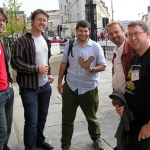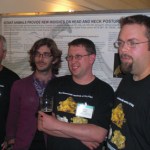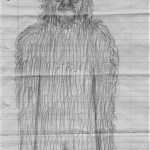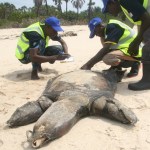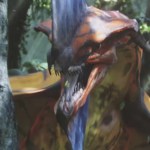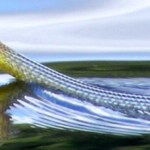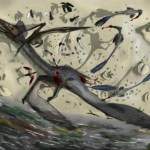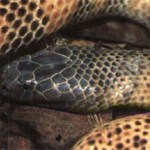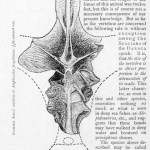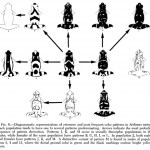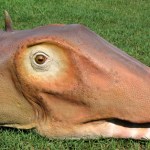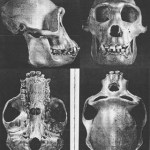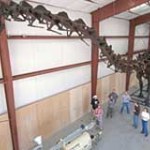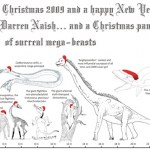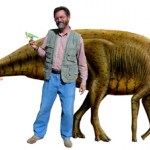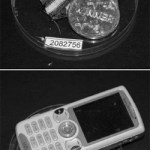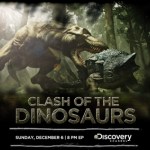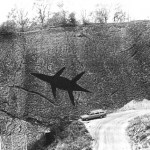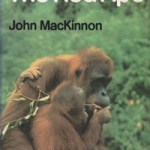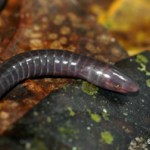
So, if you read the previous article, you'll know that we're here because Tet Zoo was four years old on January 21st. In that article, I got as far as discussing blog-relevant events that happened up to the end of May or so. Time to crack on...
During June I had a particularly bizarre job - I did a day's worth of radio interviews on behalf of The Sun newspaper. They were running a promotional event that tied in with the British tour of the Walking With Dinosaurs Live show (incidentally, I was fact-checker for the script of WWD Live when I worked at Impossible Pictures). Felt a bit weird…
Today is January 21st which means, believe it or don't, that it's Tet Zoo's birthday, the 4th no less. Holy crap... have I really been blogging for four years? Yikes, and there is still so much to do, so little ground I've covered. This is despite more than 635 (count 'em) Tet Zoo articles here on ScienceBlogs alone. As on some (but not all) of the previous occasions, this article is going to be a personal look back at the year, not a proper review of all the Tet Zoo-relevant stuff that happened in 2009 (wow, wish I had time for that). Actually, this is just about the worst time to write a…
Like many people interested in cryptozoology (the study of animals - or alleged animals - known only from anectodal evidence), I'm of the opinion that the Australian Yowie is one of the most problematic of mystery beasts. It is, in fact, so ridiculous and inconvenient that it's difficult to take seriously. As if sasquatch, yeti and orang pendek aren't difficult enough*, what are we to make of antipodean reports of a hairy, bipedal, ape-like creature? Back in 2006 (oh my god, four years ago already), Tony Healy and Paul Cropper collated everything known about the Yowie for their book The…
If you're a long-time Tet Zoo reader you might remember the article about giant Asian softshell turtles from November 2007. That article - which mostly focused on the several Chitra species - was colourfully titled 'The goat-eating hot water bottle turtles'. As you may recall, the 'goat-eating' bit was inspired by a comment made in a turtle book (David Alderton's Turtles & Tortoises of the World): according to this source, Chitra 'may even attack goats, overturning them' (Alderton 1988, p. 165). That always seemed like a puzzling statement, but I decided to run with it. As kindly pointed…
Tone and I recently went to see Avatar. I've been reading up on the movie for months and was really looking forward to seeing it. I mostly liked it, though did think it was a bit clichéd and predictable. But I'm not here to talk about storylines and plot devices... you want to know about the creatures. A lot of thought and time obviously went into the design of Pandora's ecosystem and creatures. In part, I'd say that this was a success: a lot of people (even many not that interested in the natural world) have been very much taken in by the movie's xenobiology - if only this inspired them to…
Can you identify this South American snake? The photo comes courtesy of Paul Nicholas, who spotted the snake (which was about 1 m long) while it was crossing a river below the Great Falls and King George Falls in the (mostly unexplored) upper Essequibo region of Guyana. The strange-looking lumps are water drops. Paul's guides were not able to identify the snake - can you? I confess I haven't tried too hard... field guides on Guyanan snakes are thin on the ground round here...
But, with its enormous eye and parallel dorsal strikes, the animal (which is a 'colubrid') should be identifiable (if…
Today see the launch of an outstanding new website devoted entirely to pterosaurs, the flying reptiles of the Mesozoic. What makes the site different from many specialist sources on the internet is that it was created, written and designed by specialists in the field. As such, it should prove an invaluable resource. I'll try and keep this brief, as I know you're just desperate to go over there and start looking around...
Pterosaur.net had its genesis at the Munich pterosaur meeting in 2007 when Dave Hone, John Conway, Ross Elgin, Mike Habib, Luis Rey, Lorna Steel, Mark Witton and yours truly…
A stocky, medium-sized (up to 2 m long) and poorly known elapid with notably small eyes, Micropechis ikaheka - the Small-eyed or Ikaheka snake - is the only recognised member of its genus*. It's unique to New Guinea and some of the surrounding islands [adjacent image from Warrell et al. (1996)].
'Ikaheka' means 'land eel' in the local dialect and refers to the fact that it is sometimes associated with streams and other damp habitats. Micropechis is secretive, nocturnal or crepuscular and hunts for reptiles, frogs and mammals in cluttered rainforest and wetland habitats. It is regarded as…
By popular demand... it's the second part of the old, old, old (ver 1) article I wrote in 2006 on the obscure and poorly known mega-sauropod Amphicoelias fragillimus. Be sure to read part I first.
So, A. fragillimus was described in 1878 on the basis of an incomplete but enormous dorsal vertebra and the distal end of a femur [both reconstructed in the image below]. The details of these bones show that A. fragillimus was a diplodocoid, and thus related to more familiar taxa like Diplodocus and Apatosaurus. Despite its absurd size - suggesting (by comparison with other diplodocoids) a total…
South America has a diverse and well-studied toad fauna. The continent's toads include some decidedly untoad-like taxa, such as the brightly coloured stubfoot toads or harlequin frogs. These remarkable little animals are superficially similar to the better known poison-dart frogs. What makes South America's toads particularly interesting is that several of them occupy a basal position within bufonid phylogeny: in the phylogeny generated by Frost et al. (2006), Melanophryniscus, an Atelopus + Osornophryne clade, and Dendrophryniscus are all at the base of Bufonidae, while in Pramuk et al.'s (…
Davide Bonadonna kindly sent on these pictures of a Diplodocus model he produced (with assistance provided by Simone Maganuco) during Summer 2009 for the Capellini Museum in Bologna. 2009 was the centenary year for the installation of the museum's Diplodocus carnegii replica skeleton: as I'm sure you know, it's one of eight D. carnegii casts sent around the world by steel magnate Andrew Carnegie. Why send the cast to Bologna, and not Rome, Milan, Florence, or Naples? For the answer, look at the document here.
You'll note that the model had a wide, rectangular muzzle. This is absolutely…
We've had reason now and again to mention the unusual ape photographed at Yaounde Zoo (in Cameroon) a few times. I finally got round to digging out and scanning the only photo of the animal I've seen: it was taken by Peter Jenkins and Liza Gadsby and first appeared in the November 1996 issue of the Newsletter of the Internal Primate Protection League (IPPL). It was later published in issue 100 of Fortean Times.
Jenkins and Gadsby thought that the animal might be a gorilla-chimp hybrid. I can't help but get this impression too, mostly because the eyes look gorilla-like while the rest of the…
Hope you had a good Christmas - I did! Here's an old article from Tet Zoo ver 1, apologies if you recall it from its first airing in 2006. The article is now a bit dated - sorry about that (I've added one or two new bits).
Even if you're not an expert on dinosaurs, it's likely that you've heard - firstly - that some sauropods were rily, rily big and - secondly - that these biggest of the big included such whoppers as Seismosaurus, Supersaurus and Argentinosaurus. It's always helpful that their names are easy to remember. Recent work has not only resulted in the publication of reasonably…
In time-honoured fashion, once more it's time to wish you all best Christmas wishes and share with you my digital 'Christmas card'... though if you're a regular correspondent or one of my Facebook friends you'll already have seen it, sorry...
A larger version is available on request. You'll note a random assortment of real and not-so-real tetrapods. Qilin parungulatus comes from this article, Anachrodactylus is explained here, and the idea that Deinocheirus might have been an arboreal slothosaur is discussed here (the idea is certainly erroneous, by the way). The giant pongine is, obviously…
Long-time readers might have noticed that I tend not to cover new dinosaur stories here at Tet Zoo. Partly this is because I like to be novel: I can't help but feel slightly disappointed when the subject I'm blogging about gets covered on a hundred other blogs and news-sites. It's also partly because dinosaurs get way too much coverage as it is: my aim here is to reflect tetrapod diversity as a whole, and not to focus on the attention-grabbing taxa alone. And I've done dinosaurs quite a lot already. So, sorry Aardonyx, Tawa, the proposal of venomosity in dromaeosaurs, and all those million…
Welcome to another article in the 'over-enthusiastic swallowing' series. As was the case with the previous article (the one on Mushu the pet bearded dragon), this one doesn't involve the death of the animal(s) concerned. In fact - so far as we can tell - the creature(s) that did the swallowing didn't suffer any ill effects from its/their behaviour at all. The creatures concerned are gulls: specifically, Herring gulls Larus argentatus and Lesser black-backed gulls L. fuscus [adjacent image from Camphuysen et al. (2008); read on].
Camphuysen et al. (2008) were interested in finding out what…
You're being interviewed for a TV documentary, and that documentary will focus on your special area of expertise. For the purposes of this article, let's pretend that you're an expert on sauropod dinosaurs. While being interviewed, you're asked about the possible function of a peculiar and enigmatic structure: the cavernous expansion present in the sauropod sacral region. As everyone knows, the idea that the sacral expansion might have functioned as a sort of 'second brain' was once mooted in the literature, and - because it was a fun idea that jived well with the well-known fact that…
I have to admit that I don't find trace fossils - the vast majority of which are footprints - that interesting. But some trace fossils are very neat and provide excellent information on behaviour and lifestyle. Examples include pterosaur take-off traces, the trackway of the little theropod that does an abrupt about-turn and runs back the way it came, and the Myotragus tracks that show how individuals had to stagger and battle through wet sediment in order to escape alive.
Particularly fun are giant mystery traces: the ones made by large animals doing unusual things... yet what these large…
Over the past couple of months I've been reading John MacKinnon's In Search of the Red Ape (Collins, 1974) - one of the first books anyone reads whenever they want to learn about orangutans. The book is stuffed full of anecdotes and other natural history tales about Borneo and Sumatra, and it seems that MacKinnon (who, these days, is best known for his association with the discovery of the Saola Pseudoryx nghetinensis in Vietnam (MacKinnon 2000, Van Dung et al. 1993, 1994)) encountered just about every creature you could hope to encounter in the tropical jungles of the region... yes, even…
More thoughts on the ZSL meeting 'The Secret World of Naked Snakes', held on Monday 7th December. In the previous article I discussed Mark Wilkinson and David Gower's presentations [for relevance of pic used above, read on].
Alexander Kupfer was up next, and provided an excellent overview of reproductive diversity, viviparity and parental care in caecilians (his talk was titled 'Yummy mummy: skin feeding and caecilian reproductive biology') [images above, from Wilkinson et al. (2008), show mother Siphonops annulatus looking after, and feeding, babies]. Caecilians exhibit five different…
